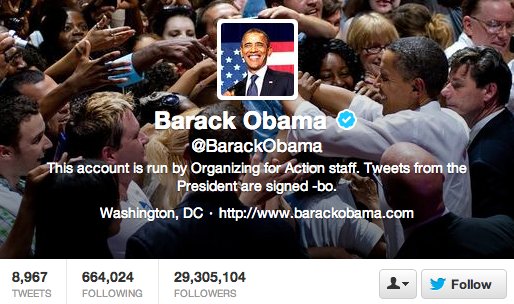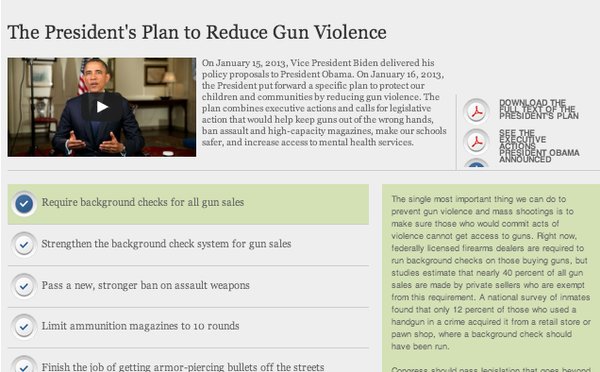Brands
Politics of Content: Obama, the Press and Democracy
When the marketing world talks about brands that are “social savvy” and “kings of content,” the focus usually falls on a few favorites, names like Old Spice, Red Bull, Amex, and Oreo.
But what about the brand that puts all others to shame? The brand that has used social content to rally the support of millions, and demonstrated that Twitter and Facebook have more marketing power than anyone thought possible? The brand that’s rewriting 200-year-old media rules as we speak?
We don’t often think about the Obama administration as a brand. But we should.

The Puppet Master?
Recently, Politico made headlines with “Obama, the Puppet Master,” a story that cast President Obama as a “master at limiting, shaping and manipulating media coverage of himself and his White House.” According to Politico, the Obama administration does this by eschewing press corps stalwarts like The Washington Post, Politico, and The New York Times in favor of friendly, “softball” interviews and social media interactions.
The complaints sound like sour grapes from a political news organization that has seen Obama’s following and reach greatly exceed its own, shifting the balance of media power in the president’s favor. Past presidents needed the journalism big boys to get their messages out, but if President Obama wants to reach millions of Americans, he doesn’t need The Post — all he needs is his Twitter login.
The Obama administration, of course, isn’t the only brand that’s figured out that it can be its own media company. Major brands used to need media outlets to reach consumers; now, all they need is new media skills and something interesting to say.
A Journey to Social
If every brand could amass 32 million Facebook fans and 28 million Twitter followers like Obama, the marketing world would be a much different place. But the presidentdidn’t amass his media empire overnight; it took six years of dedicated social engagement to build.

In February of 2007, shortly before announcing his candidacy for president, then-Senator Obama spoke with his friend Marc Andreessen, founder of Netscape and a Facebook board member. They met late at night at a San Francisco airport. According to The New York Times, Obama asked Andreessen if social networking could help him defeat the powerful Clinton political machine.
“It was like a guy in a garage who was thinking of taking on the biggest names in the business,” Andreessen told The Times. “What he was doing shouldn’t have been possible … He was clearly supersmart and very entrepreneurial, a person who saw the world and the status quo as malleable.”
To attract support through Facebook and Twitter, Obama needed to create content that would deliver value to people’s lives and inspire them to spread the word. Luckily, Obama already had a “Patient Zero” for that kind of viral content: Obama’s 2004 DNC speech, which captivated Americans with its message of hope, and became one of the first political speeches to go viral on YouTube. Obama would go on to win the presidency by delivering non-stop doses of hope through social media.
Content: The Ultimate Political Weapon
By the time Obama was sworn in, he had amassed millions of followers on Facebook and Twitter and had the email addresses of millions of supporters. In other words, he had a direct line to the American people. President Obama used that direct line to rally support during his bloody battles with Republicans over health care, the deficit, and everything in between.
President Obama also turned this policy talk into a two-way conversation, launching the We The People petition platform in September 2011 and promising a response to any petition that garnered 25,000 electronic signatures.
As the Obama presidency matures, the administration is getting better and better at using social content as a weapon in battles with Republicans. Politico’s “Puppet Master” story focuses on one instance in January, when the White House released a photo of President Obama shooting skeet at Camp David, in order to end speculation that the President had lied when he told The New Republic that he shot skeet “all the time.” Instead of handing the photo to the press, members of Obama’s senior staff tweeted the photo out to the masses. David Plouffe’s tweet was particularly entertaining and masterfully crafted: “Attn skeet birthers. Make our day — let the photoshop conspiracies begin!”
This move clearly irked Politico, and it’s a sign of how the times have changed. The political junkie who religiously read The Times 15 years ago is now the political junkie who follows Plouffe on Twitter. He won’t need to read Plouffe’s words in The Times, where they would most likely be juxtaposed to critical quotes from the other side.

The skeet tweet was part of President Obama’s multi-pronged content attack to sway American opinion on gun control. Since the shooting, President Obama and Vice President Biden have both talked gun control policy with Americans via Google Hangouts. After user David G. launched a gun control petition on the We The People platform that became the most popular cause ever on the platform, the White House released a comprehensive response, including a personal response video from the president, which was viewed almost 400,000 times. The White House also quickly launched a stunning and informative micro-site on preventing gun violence. It’s the kind of work that ad agencies gush over at SXSW and Cannes.
While the White House Press Corps may be getting less access to President Obama, the average American is getting much more access than ever before. The White House’s digital briefing room lets you track everything from the President’s daily schedule, to his pending legislation, to each White House press briefing. President Obama also films a weekly Saturday morning address to the nation, and Vice President Biden is launching an photo-podcast series, dubbed “Being Biden,” that gives Americans a behind-the-scenes peak at the VP’s life off the public schedule. All of this content, in addition to various other images and infographics that support Obama’s positions or put him in a flattering light, is distributed through the White House’s various social channels.
The Obama administration is on a never-ending mission to execute the golden rule of content marketing: Figure out what your fans are talking about, and own that conversation. Whether the conversation is about gun control, taxes, Michelle’s bangs, or the day-to-day happenings of The White House, the Obama administration owns the talking points masterfully. It’s time for brands to take note and learn a few lessons from the greatest brand publisher on the planet.
Get better at your job right now.
Read our monthly newsletter to master content marketing. It’s made for marketers, creators, and everyone in between.




